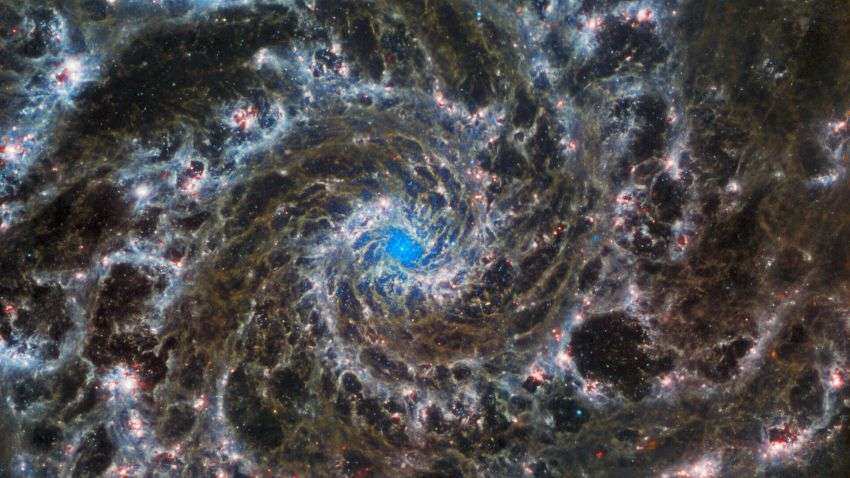Stunning image! NASA's James Webb Telescope captures 'Phantom galaxy' like never before - view photo
James Webb Telescope: Webb noticed M74 with its Mid-InfraRed Instrument (MIRI) to learn more about the earliest phases of star formation in the local universe.

James Webb Telescope: NASA's James Webb Space Telescope has captured a stunning new image of the Phantom Galaxy, which is otherwise called M74. The picture revealed the delicate filaments of gas and dust in the grandiose spiral arms which wind outwards from the centre of this image.
Webb's sharp vision pictured an unobscured view of the nuclear star cluster at the galaxy's centre, complimented by lack of gas in the nuclear region.
What is M74?
M74 is a spiral galaxy of a particular segment, which is classified as a ‘grand design spiral’. The galaxy's arms are prominent and well-defined unlike other galaxies in space which have patchy and ragged structure.
M74, also called Phantom Galaxy, is about 32 million light-years away from Earth and lies almost face-on to Earth. The prominent spiral arms of this galaxy make it a most-chosen target for astronomers studying the origin and structure of galactic spirals.
Webb noticed M74 with its Mid-InfraRed Instrument (MIRI) to learn more about the earliest phases of star formation in the local universe. To study nearby star-forming galaxies, these observations were made by PHANGS (Physics at High Angular resolution in Nearby Galaxies) collaboration. The neighboring galaxies have already been observed using the NASA/ESA Hubble Space Telescope and ground-based observatories.
Feast your eyes on the beautiful spiral structure of the Phantom Galaxy, M74, as seen by Webb in the mid-infrared. Delicate filaments of dust and gas wind outwards from the center of the galaxy, which has a ring of star formation around its nucleus. https://t.co/pPVvxsC6KA pic.twitter.com/JQ2C9Wf19f
— NASA Webb Telescope (@NASAWebb) August 30, 2022
The recent James Webb's addition of well-defined observations at longer wavelengths will give astronomers an opportunity to pinpoint star-forming regions in the galaxies. Furthermore, accurate measurement of the masses and ages of star clusters and insights into the nature of the small grains of dust drifting in interstellar space, will also be possible.
Earlier observations of M74 revealed bright areas of star formation known as HII regions. Scientists gain greater insight into astronomical objects by accumulating data from telescopes operating across the electromagnetic spectrum.
Get Latest Business News, Stock Market Updates and Videos; Check your tax outgo through Income Tax Calculator and save money through our Personal Finance coverage. Check Business Breaking News Live on Zee Business Twitter and Facebook. Subscribe on YouTube.
06:40 PM IST












 SpaceX secures $843 million NASA contract to de-orbit ISS by 2030
SpaceX secures $843 million NASA contract to de-orbit ISS by 2030 NASA continues to further India-US iCET initiative for "benefit of humanity", says administrator Bill Nelson
NASA continues to further India-US iCET initiative for "benefit of humanity", says administrator Bill Nelson Indian-origin astronaut Sunita Williams set to fly into space for a third time on Tuesday
Indian-origin astronaut Sunita Williams set to fly into space for a third time on Tuesday China set to launch high-stakes mission to moon's 'hidden' side
China set to launch high-stakes mission to moon's 'hidden' side NASA astronauts lose tool bag during first spacewalk
NASA astronauts lose tool bag during first spacewalk